Disclosure: This post contains affiliate links and we may receive a referral fee (at no extra cost to you) if you sign up or purchase products or services mentioned. As an Amazon Associate, I earn from qualifying purchases.
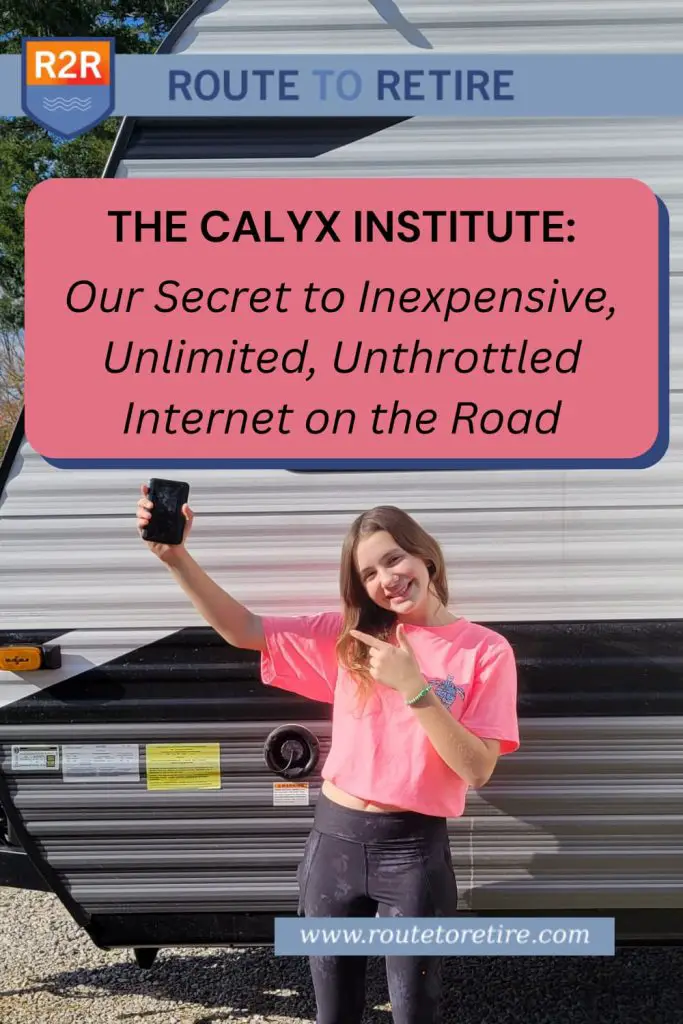
Well, after almost a month of living in our new trailer at two local campgrounds to get the hang of things, we’re finally off and running. We’ve started our road trip around the country with an anticipation of finishing in early summer next year!
I think we did a good job learning as much as we could beforehand because things have gone relatively smoothly thus far. Sure, there have been some minor things like me getting sprayed down from water from the cooled-down hot water tank (oops!), but it’s all part of the process, and that one made for a good laugh.
One of the concerns we had during our preparation was how we would get internet while on the road. The most important aspect of this is that Faith needs to continue doing her homeschooling. But besides that, we want internet access to plan our next stops, to be able to stream movies some nights, and really just to stay a part of civilized life. Plus, I want to continue posting on this site and my YouTube channel while we do this.
Some solutions work well but tend to be expensive. Others are cheap but are very limited or they’re clunky and not as effective. Another popular solution in the RV world tends to work but falls into a gray area of violating the terms of service.
So what’s a family like ours supposed to do?
The Calyx Institute to the rescue! I’ll tell you what this is, why we went this route, and how it’s been going so far. I’ll also hook you up with a nice little incentive if you’re looking to get in on this cool solution!
- Some popular internet solutions for travelers and the problems they come with
- What is the Calyx Institute?
- Why we liked the Calyx Institute solution
- It's truly unlimited
- A Calyx Institute membership is very cost-effective
- It uses T-Mobile's network and 5G where available
- It's about the size of a cell phone
- It sometimes provides a better signal and faster data than our cell phones
- We can use it while driving
- We're complying with the Calyx Institute terms of service while on the road
- How's the Calyx Institute hotspot been working for us?
- Get an extra month for free from the Calyx Institute
Some popular internet solutions for travelers and the problems they come with
Getting online while on the road for work or pleasure is something that’s sought after by almost everyone nowadays. Some folks need to be connected for their jobs while some just want to be able to keep up with friends or watch a movie or show on a streaming service before going to bed.
As far as campground WiFi goes, I’m sure most RV travelers can tell you that in most cases, it’s simply not good. So you almost always will want an alternative if you need internet access. And if you’re hoping to boondock quite a bit like we’re planning to do, campground WiFi can be irrelevant most of the time anyway.
Whatever the case, there are a lot of different options out there. Here are just some of them with what I liked and what I didn’t:
Starlink
One of the biggest game-changers to gaining internet access is Elon Musk’s Starlink. Using low-orbit satellites, you can now get high-speed internet almost anywhere in the world. The speeds are really good and most of the time folks seem to get reliable service from it. They even offer a product/service called Roam that’s essentially designed for RV’ers!
This would have worked reasonably well for us, particularly because we plan to do a lot of boondocking on this trip in locations that could be pretty rural. That usually equates to not having a good signal, if any at all.
There were two reasons I didn’t want to go this route though:
- Cost – Their prices change frequently so this could change at any time, but currently their Mobile Regional plan runs $150/month, which is quite a bit more than I wanted to spend. Oh, and there’s a one-time hardware cost of $599, too… ouch.
- Equipment – We’re going to be moving around a lot. I don’t want to be lugging around a satellite receiver and needing to set this up every time we stop. Besides that, the hardware is a hot commodity and I’d probably want to figure out how to lock it up each time as well.
So I passed on this – though it could be an excellent option for you if those cons don’t bother you!
Cell phone with hotspot
A lot of people will just use their cell phones for internet connectivity. Most plans have an option that’s sometimes free to use your phone as a hotspot. Turn that on and your phone acts like a wireless router to give all your devices access to the internet.
The nice thing about this is that you don’t need any extra equipment. A downside to that though is that if you run to the store with your phone while your family stays at the RV, for example, they’ve just lost their internet gateway.
Also, if you don’t have unlimited data on your plan, streaming video will chew up your data allotment pretty quickly. And with most plans, even if you have unlimited data, it gets throttled after a certain amount is used (so much for unlimited, right?!).
Here’s one other point I only learned about recently, too… a lot of carriers will deprioritize hotspot data anyway. That has the potential to make it difficult when streaming or trying to do anything else worthwhile.
You’re also likely going to be tied to one carrier, too. If your phone plan is through Verizon, for instance, you’ll get a good signal as long as Verizon’s got coverage in the area. If T-Mobile’s signal is great and Verizon’s isn’t, sorry about your luck – that’s the way it goes.
Mobile hotspots
A step up from using your phone as a hotspot is to buy a dedicated mobile hotspot (aka Jetpack/MiFi). These are devices that essentially do the same as what a hotspot on your phone would do except they’re more efficient at it.
The hotspot devices are available from the major carriers (Verizon, T-Mobile, AT&T) or from other companies that lease bandwidth from the big 3. The devices could be completely subsidized or could be as much as several hundred dollars depending on what you want.
A major con to these though is that you’re probably going to need to pay for a separate monthly plan for the hotspot… and you’re not likely to find one with that generous of a data cap. Maybe you’ll find a deal for $50/month for 100GB of data. While 100GB per month might be plenty for many folks, for others, that’s not going to cut the mustard.
And like using your phone as a hotspot, you’re good wherever that carrier’s signal is good. If it’s not good in the area, that hotspot is basically a brick for the time you’re in that area.
Verizon or T-Mobile Home Internet
I’ve noticed quite a bit that many people are utilizing the Verizon 5G Home Internet or T-Mobile 5G Home Internet for their internet needs on the road.
If you’re not familiar, Verizon and T-Mobile have created what amounts to a more robust hotspot device for home internet. This allows them to compete with the stupid monopoly cable companies that locked out all other competition when they came into areas. But since these are using 5G cell signals instead of cable, businesses can now compete for home markets.
While the speeds aren’t mind-blowing (yet), for about $50/month, you can get home internet that should handle most consumers’ needs. You get a router that you plug into a power outlet and you’re all set. Just connect your devices to the WiFi on the router and your connection goes out to the internet using a 5G signal – just like your phone or a hotspot.
The big difference is that you’re not usually capped with unlimited high-speed data.
Cool, right?
But here’s the deal – it’s meant to be used for your home address. The terms and conditions don’t want you to use this as a traveling device. Although you can update your address online and it’ll probably work for you in most places you go, it doesn’t mean it’s technically allowed. And if they want, they can shut you down at any point if they want to enforce it.
So as you can see, a lot of pros and cons out there for different internet options. You might have found something in there that works for you or you might not have. I stumbled onto something that fit my needs a little better though… the Calyx Institute.
What is the Calyx Institute?
The Calyx Institute is a pretty unique entity. Here’s some info from their “About” page:
“We are a non-profit education and research organization devoted to studying, testing and developing and implementing privacy technology and tools to promote free speech, free expression, civic engagement and privacy rights on the internet and in the mobile communications industry.”
— About The Calyx Institute
Wait – a company that’s aiming to help people with privacy and technology and is not trying to suck every penny out of their living souls? What???
Anyway, that’s the premise of the Calyx Institute and they’ve been around since 2010. They offer up several cool projects that you can see on their Projects page, but the one we’re focused on right now is their Mobile Internet.
In a nutshell, they can provide truly unlimited mobile internet through a hotspot device utilizing the T-Mobile network.
The way this is done isn’t by just buying the device and plan. Instead, you make a tax-deductible contribution (you heard that right, finance nerds!) to become a contributing member of the Calyx Institute. Then as a member, they send you one of a few different types of hotspot devices for free (depending on the contributor level you chose).
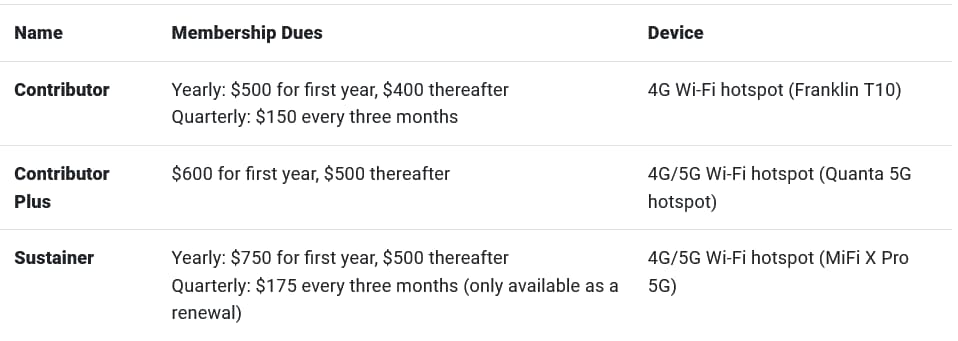
When you get the device, you just pop in the included SIM card, power it on, and you’re ready to go. You’ll then have free unlimited internet for a full year (more on that later!). If you need it longer than that, you can then renew your membership at a cheaper cost each year.
Why we liked the Calyx Institute solution
The Calyx Institute offered an interesting dynamic that appealed to me for several reasons:
- It’s truly unlimited
- A Calyx Institute membership is very cost-effective
- It uses T-Mobile’s network and 5G where available
- It’s about the size of a cell phone
- It sometimes provides a better signal and faster data than our cell phones
- We can use it while driving
- We’re complying with the Calyx Institute terms of service while on the road
Let’s dig a little deeper into each of these.
It’s truly unlimited
I already talked about a problem with the majority of cell phone and hotspot plans – they’re not truly unlimited. With so many plans, the providers are somehow able to use the word “unlimited” and then still set data caps or throttle your connection at some point. Why is this even legal? If it’s supposedly unlimited, it should be truly unlimited.
Anyway, with a Calyx Institute hotspot, your data is truly unlimited. As they put it:
How unlimited is the unlimited internet from Calyx Institute?
— Calyx Institute – Data Usage
Our contract with Mobile Citizen says “no throttling, suspension, or overage charges after 30GB”. We are authorized by Mobile Citizen to describe the service as “unlimited” because there is no limit to the amount of data you can use, and there never has been.
I like that. That means no worries about using too much data at all while traveling around the country.
A Calyx Institute membership is very cost-effective
When you first look at the pricing for a Calyx Institute membership, you might be thinking, “Holy @#$% – $500-750 for this?? That’s way too much money!”
But that’s the wrong way to think about it. Remember, this is for a year-long membership and that’s all you’ll pay for the entire year.
In our case, we went with the Contributor Plus membership which cost $600 for the first year ($500 each year thereafter). We actually got 13 months on this instead of 12 (more on that shortly), so that comes out to be just over $46/month for unlimited internet access. That’s a heckuva lot less than we were paying for internet access at home!
As a little icing on the cake, it’s also a tax-deductible donation so if you’re able to itemize, not a bad deal there either.
When we get back from this adventure on the road, I’ll probably use this as a replacement for home internet for a while.
It uses T-Mobile’s network and 5G where available
The hotspots from the Calyx Institute use T-Mobile’s network. There’s no roaming and it’s only good for coverage in the U.S. However, T-Mobile currently has more 5G coverage in the U.S. than Verizon and AT&T combined. If you don’t know it, 5G is what you want when possible – that generally provides the fastest data connection. 4G/LTE is the fallback and T-Mobile has excellent coverage on that front as well.
Here’s a picture of T-Mobile’s coverage map in the U.S. as of this writing…
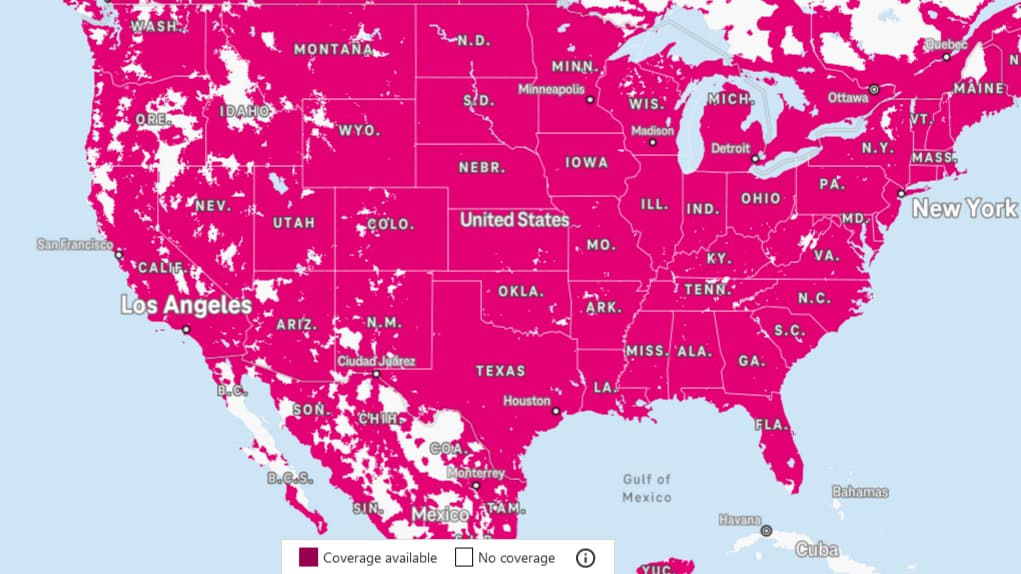
Now, this is important to keep in mind – the big concession on this versus satellite internet like Starlink is that we’ll only have internet where T-Mobile coverage is available. So there will be times when we’re boondocking that we just won’t have internet at all. Based on their coverage map though, I’m hoping that won’t be too often. And considering how much less expensive and easier this is to deal with over Starlink, I’m willing to sacrifice for those times.
It’s about the size of a cell phone
Portability is important to me. We’re going to be setting up shop maybe a hundred times or more at different campsites. I don’t want to lug out a satellite receiver every time we get to a new destination (and, of course, put it away when leaving). We also don’t have a huge RV trailer so storage is at a premium for us.
The 4G/5G Wi-Fi hotspot we got from the Calyx Institute with our membership (a Quanta 5G hotspot) is slightly larger than the size of the average cell phone. And it just plugs in with a standard USB-C cable as well.
I added a little adhesive phone holder similar to this one from Amazon and now, when we arrive somewhere, I just pop it in there and call it a day.
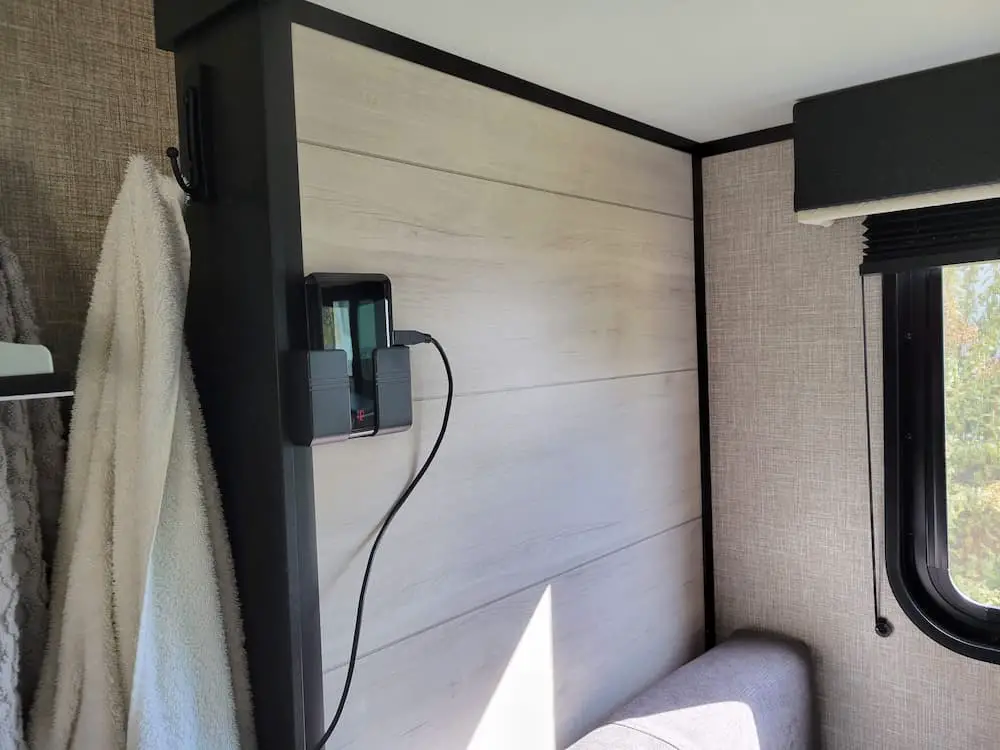
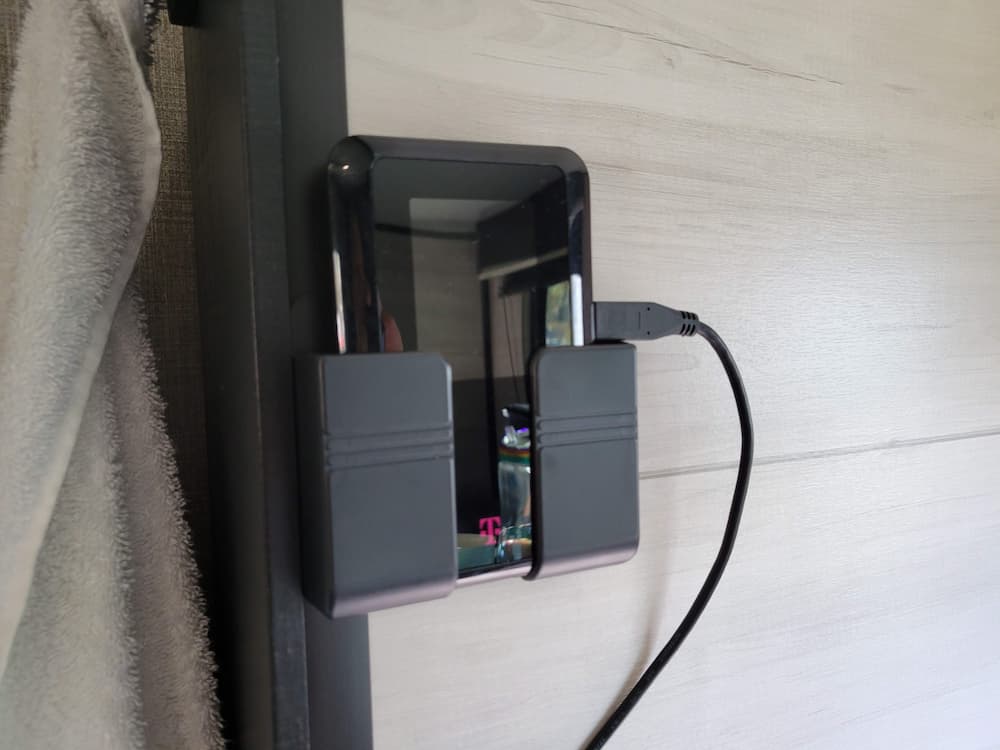
Simple, easy, and out of the way.
It sometimes provides a better signal and faster data than our cell phones
Lisa, Faith, and I have now been on Mint Mobile for about a year and a half for cell phone service. You can read more about my thoughts on the service in my post, Mint Mobile Review: 1 Year Later – Does It Live Up to the Hype?
If you’ve been itching to try out Mint Mobile, you can get $15 in credit by using my referral link, Lisa’s link, or Faith’s link.
While we’ve all been very happy on that end, we also know that it’s an MVNO that doesn’t provide prioritized data. Mint Mobile uses the T-Mobile network and when you’re in a congested area, official T-Mobile customers with certain plans get prioritized data (sometimes known as premium data) over others. That can lead to a slow or unreliable internet connection.
Although it’s been rare for us to see that on Mint Mobile, it does happen.
I didn’t confirm this with the Calyx Institute, but I’ve read in several places (here’s one) that the Calyx Institute devices have more prioritized data (at least up to 50 GB/month) than we get through Mint Mobile. That means that if we’re in a busy area where we might not get prioritized data with our cell phones, we would with the hotspot from the Calyx Institute.
Also, because we keep the hotspot mounted right by a window in the RV while we’re set up somewhere, we tend to have a better signal than we do with our cell phones…
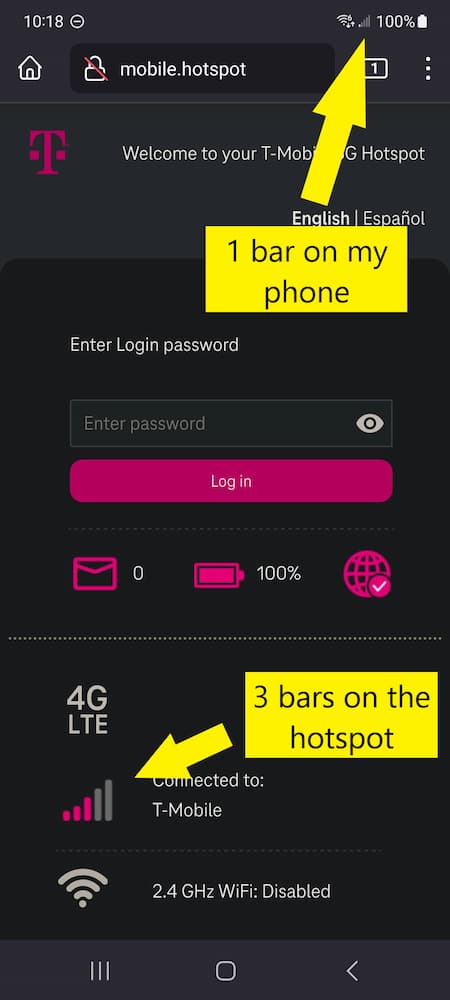
We can use it while driving
This is just a cool bonus. When we’re on the road, we just leave the Calyx Institute hotspot on in the car. Our phones and laptops are already connected to it via WiFi so that allows us to take advantage of the unlimited data while out and about.
If Faith wants to do her homeschooling or even just stream a movie while in the car, she doesn’t even have to think twice about it. If Lisa or I want to download anything or do a video chat, it doesn’t pull from our phone plan. This allows us to keep a modest phone plan (we have 15 GB of data each which still might be a little much) because the hotspot plan takes most of the weight off of any possible data concerns.
It’s just like being on the internet while at home except we’re able to do this on the road, too.
The hotspot does have a battery and is supposed to get several hours of battery life, but we just leave it plugged into a car charger so that’s not a concern either.
Pretty cool, right?
We’re complying with the Calyx Institute terms of service while on the road
Last but not least, we’re not breaking any rules while using the hotspot from the Calyx Institute. I’m only bringing this up because it seems like a lot of people talk about signing up for Verizon or T-Mobile Home Internet and bringing the router with them on the road.
Although this might work, this isn’t ideal.
First of all, Verizon’s Home Internet terms of service state that the service is intended for use in a single residential location. So you’d be breaking the terms by doing this. Although some folks change their “home address” at each stop they make, that’s not really keeping with the spirit of the rules.
T-Mobile is a little more flexible in allowing it, but they talk about throttling your usage if you’re using a lot of data or if the network is congested.
Secondly, why bother doing this if a viable alternative exists that complies with all terms, doesn’t throttle, and costs about the same or less than the home internet solutions?
How’s the Calyx Institute hotspot been working for us?
We’ve now had our hotspot from the Calyx Institute since the beginning of October. It showed up just in time for me to activate it, test it out at home, and then take it to the campgrounds with us to use.
I’m very happy with this so far.
At home (my mother-in-law’s house at the time), it worked well even while we were in the basement. I only used it briefly to test it and get our devices connected, but it did what it was supposed to and we got speeds that I was satisfied with…
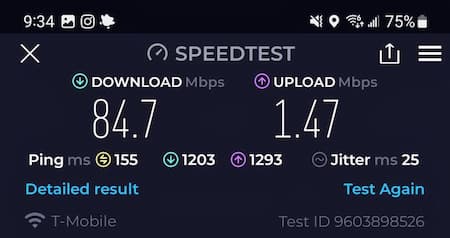
Our first campground was at Countryside Campground in Mogadore, Ohio. We just stayed there to get a feel for things for a couple of weeks. While there, I put the hotspot from the Calyx Institute in place.
We had mixed results here. Sometimes we would have really good internet and sometimes we wouldn’t. We weren’t very close to T-Mobile cell phone towers and that made for an uneven experience.
Regardless, we made do and it did the job. This was a pretty common speed test result I might get (though sometimes it was much higher and sometimes lower)…
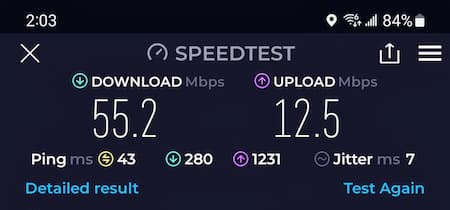
Our second campground was at Silver Springs Campground in Stow, Ohio. We stayed there for 10 days and the hotspot worked great there – no complaints. Here are a few sample speed tests throughout our time there…
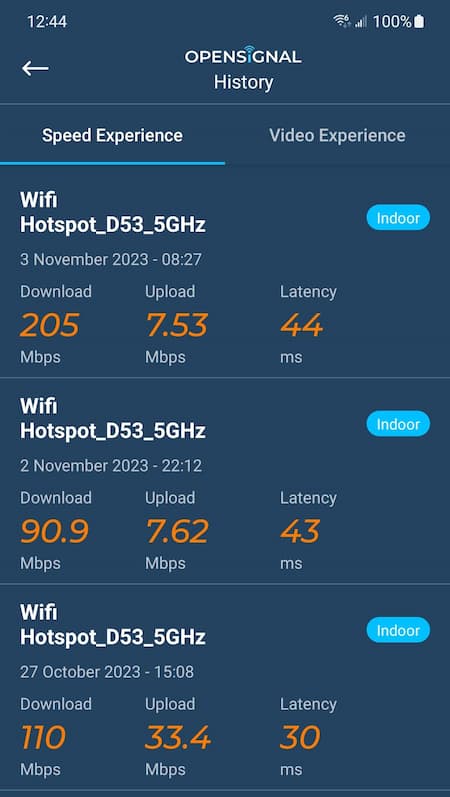
On November 1, we hit the road! We’ve stayed at a few places as we’ve been making our way down toward Texas (we should be in Tennessee as you read this). The coverage has been great at all places so far and the speeds have been plenty for us.
We’ve also been driving with the hotspot in the car. For the most part, it’s worked extremely well. Faith is the one primarily using the internet and she did need to reboot it once or twice when it wouldn’t pull a signal but it’s worked great even while in motion.
Overall, I’m happy with the choice of the Calyx Institute hotspot so far. Considering how much cheaper and easier it is to deal with than Starlink, I’m thrilled with it even knowing that there might be some places where we might not get a good signal.
Get an extra month for free from the Calyx Institute
The Calyx Institute has a nice referral program where you can get a month for free by signing up through my link (I’ll get an extra month for free as well). So instead of 12 months of service, you get 13… not too shabby, right?
Here’s the link to use to get your extra free month:
https://www.routetoretire.com/go/calyx/
Be sure that code visaf is listed as your referral code.
If you’re curious, we chose the Contributor Plus plan. The regular Contributor plan only gets you a 4G hotspot whereas the Contributor Plus plan provides for a hotspot that’s capable of 4G and 5G. For most folks, I think that the 5G is going to be pretty important to get you enough throughput to support multiple people and streaming.
Here’s what the Calyx Institute says about what to expect on speeds:
4G Speeds: In practice, 4G is rarely above 40mbps, but it can vary widely by location, time of day, and local congestion. The maximum speed a member has reported with a 4G device (and a MIMO antenna) is 100mbps. It is not uncommon to get 10mbps.
— Calyx Institute – Will it be fast?
5G Speeds: If you live in an urban environment with good 5G coverage, many members report download speed of over 300mbps. However, there is no guarentee [sic] you will get this kind of speed and there are a lot of factors that can influence the speed, including obstructions between you and the tower and the congestion on the local carrier network. It is also possible to get 30mbps and below, or no signal at all in a rural area.
There’s also a Sustainer plan that garners you a better 4G/5G hotspot but I didn’t feel that was necessary for our needs.
And that’s the scoop, folks! Things are going pretty smoothly on the road trip and we’re out of the cold that we started to get in Ohio (for now!). We went to Mammoth Cave in Kentucky the other day, which is a cool place to visit.
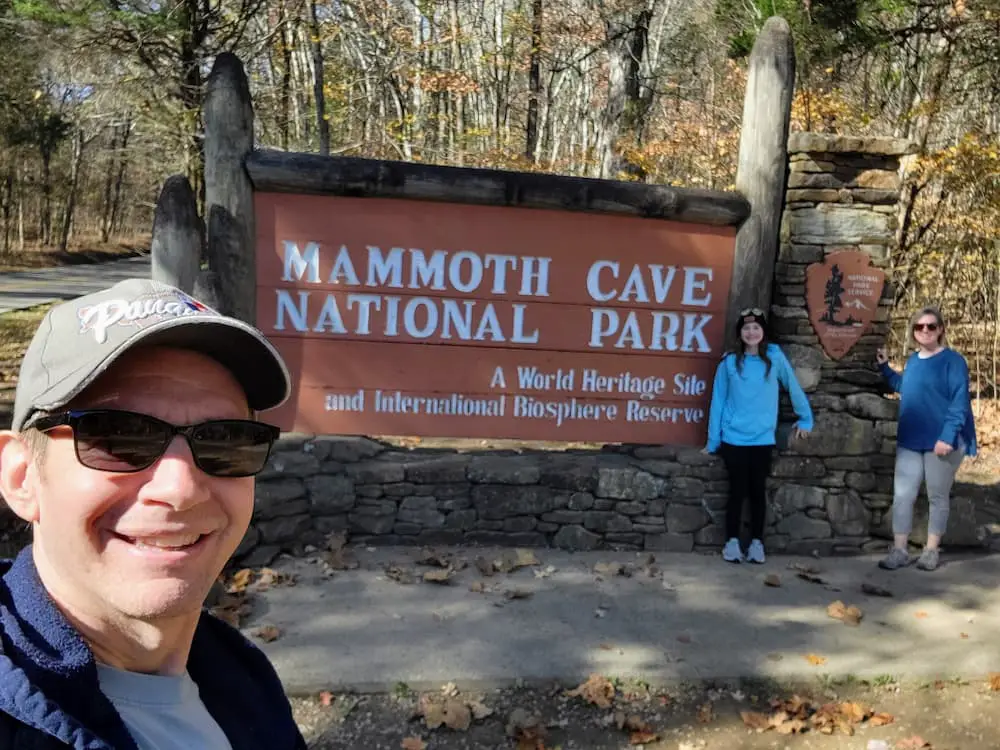

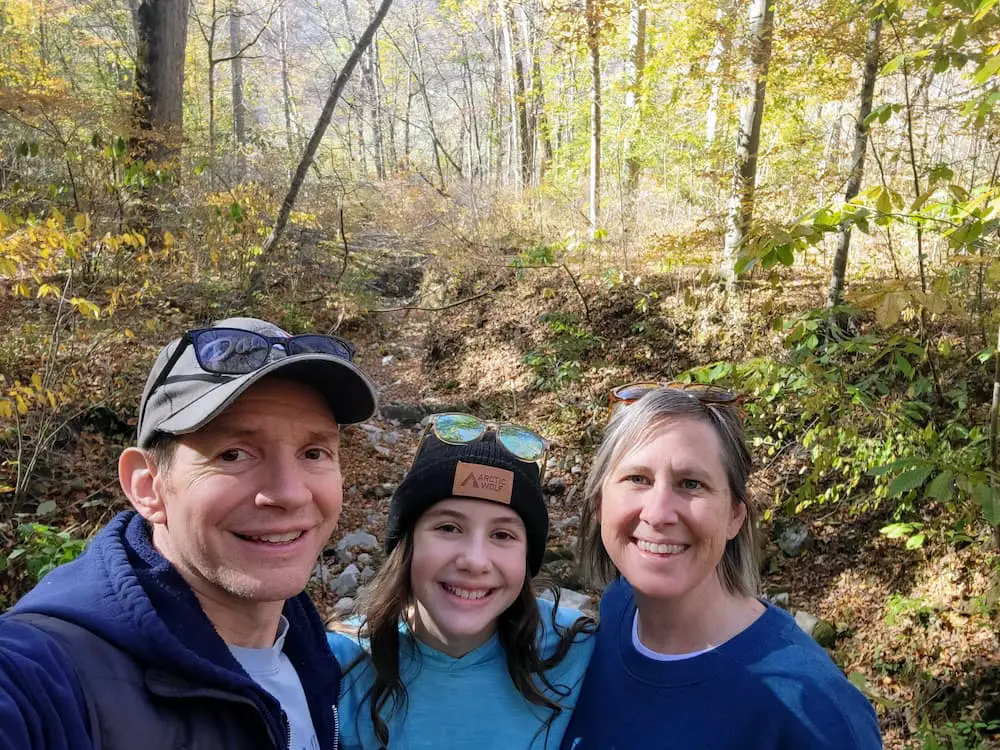
We stayed in the area for a few nights before heading toward Tennessee. Life is good!
To read about our whole RV adventure, here are the related posts from start to finish…
- You Gotta Spend Money To Make Money, Right? Our Monster Travel Experiment
- Adventure Planning: I’ve Made This Mistake Twice
- RV Boondocking: Spending a Little Money on 3 Changes Now to Reap Huge Savings and Enjoy a Better Trip Later
- It’s Amazing What Being Alone With Your Thoughts on a Walk Can Do for You
- The Calyx Institute: Our Secret to Inexpensive, Unlimited, Unthrottled Internet on the Road
- The Ups and Downs of RV Life: 45 Days in Our Tiny Home
- Our 9-Month RV Adventure: The 55+ Essential Items We Bought for the Road
- Our RV Trip Was Quickly Becoming a Florida Flop… Until We Shifted Gears
- The World’s Largest What??!! 7 Months of Our RV Road Trip Complete, 1 To Go!
- 8 Months and 13,409 Miles Later: Our RV Adventure is Over
Plan well, take action, and live your best life!
Thanks for reading!!
— Jim


Thanks for the introduction to Calyx Institute Jim, I had never heard of it. If it’s that committed to maintaining its users privacy, then I’m all about it! I will check it out further, safe travels sir, look forward to your updates!
Thanks, Jim – it’s been fun so far!
I’m heading to Nashville tomorrow for a Board meeting. Are you anywhere near that part of the state? If so, maybe we can get together for a quick visit before my business dinner tomorrow night? Also, cool solution for RV access, all new to me. We used cell hotspot during our Pacific NW trip, got throttled…
Dang it, Fritz – we’re a couple hours south of Nashville already and possibly making it to Alabama tomorrow (we’ll see). Don’t worry – you’ll be stuck hanging out once we head through your neck of the woods this winter!
And yeah, getting throttled can be so frustrating – it’s funny how we expect things instantaneously nowadays and being slowed down can be so aggravating! ????
Interesting, hadn’t heard of this one.
Another option, our local library lends unlimited hot spots by the week. Usually available as it’s not well advertised.
That’s a great option! We have those at our local library and I might have opted for that with our trip but a week wouldn’t have cut it for us on this trip. But for folks just going out of town for a week, this could be a fantastic choice!e. Thanks for sharing that, FTF!
That sounds like a really good option. I wonder if you can use it for home internet as well. I’m disgruntled because I’m paying $75/month for mediocre speed. Ridiculous.
It’s absolutely something to consider, but the issue is knowing if you’ll get good speeds with it beforehand because it’s a donation so it’s not refundable. As they say though, if you have T-Mobile phone service or have a friend with T-Mobile that can check speeds from your house, you’d have a much better idea on how well it would work. Of course, there’s the T-Mobile Home Internet solution as well if it’s offered in your area.
Re MIMO, at this time Calyx does not offer a router with ports to connect an external antenna. They suggest, dubiously imho, using a booster.
I’ve apprised them of their “guarentee” typo.
Funny enough, I appreciate that I’m not dealing with an external antenna but I can appreciate why that could be helpful for a lot of areas where the signal might not be so good.
Any advice on boosting signal? Consensus is the router stinks. Which one do you use? Thanks.
Not sure where the “consensus” is coming from – I’ve heard only good things about it and I’m happy with it as well. I’m using the Quanta 5G hotspot that comes with the Contributor Plus plan and it’s done well for me. Yes, there are areas on our travels where the T-Mobile signal isn’t great so the router doesn’t perform well there, but the signal has still performed better than our cell phones in those places (which are also T-Mobile through Mint Mobile). I haven’t gone down the path of trying to boost the signal since I’ve been very happy with the performance. Sounds like you might want to look at some other options that would work better for you.
Upon further review… indeed PC Mag also likes the Inseego. I’ll give it a whack. Thanks!
This is for my van home where I need unlimited data for professional video calls, typically using 1GB/hr for one-on-one sessions. Where service is dubious, I can drive to a more reliable location. I’m confident I’ll find good service in Denver, but would like to use Calyx at least as a backup plan in mountain towns like Dillon so I don’t have to suffer the ignominy of using Arby’s wifi all day — they might have the Meats but I’m a pescetarian. I figure a router with an antenna would offer range flexibility, but I’ll cross that divide if needed. Please let me know if you can offer any other advice, I appreciate it.
Glad that you may have found a solution that works for you. I’m not too familiar with Inseego but be sure that it meets your needs. With the hotspot from the Calyx Institute, you’re not throttled at all for unlimited data, which is a very unusual perk. I saw that not all their hotspots support 5G, too, so keep that in mind when choosing one. At a glance, it also looks like Calyx is a less expensive option than Inseego (if price is important to you). Other than that, if it works for you, perfect! Good luck!
Sorry, I mean the Inseego MiFi G5 X Pro — presumably model M3000 — which is the Calyx Sustainer membership router offering. I’ve read it’s stricken with a maddening problem where it reboots spontaneously when configured to support certain features required for some — including, I believe, me. Is this the one you use? Have you had any such intractable router issues? Thanks again, R.
Yeah, can’t help you there – I use the Quanta 5G hotspot that comes with the Contributor Plus plan.
I am in rural Maine. There is no TMobile or Verizon Home internet here. I use my phone as a hotspot and refer folks to the plan I use which is Visible Basic from Verizon. I pay a whopping $5 a month after my discount for referring people (normal price is $20-25 month)!
My truly unlimited hotspot running off Verizon Towers with 4glte is limited to one device being used off hotspot and 5Mbps data and, I believe 2 MBps video. Obviously, there are ways of bypassing those limitations but I do not. I stream YouTube at 1080 lots of times. You can use as many GB a month as you want with no throttle and TOS violation.
So, after looking at all the options you did a great job of presenting, I think Verizon Visible is unbeatable for me. It gives me unlimited talk and text too! You can use it anywhere Verizon towers are around.
A con to Verizon Visible is in congested areas, on Visible Basic you may be slowed or dropped. They have another plan that comes with priority data if congestion is a problem.
Thank you for your write up.
Thanks, Glenn – we used Visible for our phone service for a while (we now use Mint Mobile). Both are excellent MVNO providers. So we have used Visible’s hotspot and it does do the job for a nice price.
There are a few problems with it though that I’ll share for others reading. One is the data prioritization that you already mentioned – that can be a big issue for some folks depending on where they’re at and can make streaming unreliable at best. It’s also running on one phone, which is fine unless you have multiple people with you and the person with the hotspot on their phone runs to the grocery store or something – that cuts off the internet for your Fire Stick or other streaming device. It’s also hard on your phone’s battery life, which can shorten its lifespan.
But the bigger issue for a lot of folks I’ve been hearing from in the RV community is that they burn through a lot of data streaming… like a real lot. With Visible, they give you about 50 GB shared between your phone and hotspot and they throttle your speeds big time after that. That’s a show stopper for a lot of folks. It seems like a lot of people use hundreds of GBs of data every month while streaming so that wouldn’t work.
But if it works for your needs, I’m all about it. For $5/month and no other devices to have to worry about, it’s a darn good deal! 🙂
Just a quick follow-up on this. It was brought to my attention that the 50 GB of data on Visible is for their “premium” data from their Visible+ plan. Both plans do have unlimited basic data, which does make this another option for others to consider. You’d either need to do the hotspot on your own phone with this plan (I’m not really a fan of that for the reason I mentioned in my previous comment) or get another phone and add the Visible plan to it. Pros and cons to everything but again, everyone should evaluate the options and determine what would work best for themselves! 🙂
Thank you for the writeup/review, lots of good information that helped make our decision. I just completed our enrollment of Calyx and used your referral code. I hope you enjoyed your time in Tennessee!
Awesome – I’m glad you found the post useful, Cole. I hope it works out well for you, too! Thanks for using my referral link. Yes, Tennessee was cool, but now we’re out west getting to do some more boondocking and that’s even better! 🙂
Do they limit the streaming rate, i.e standard definition vs high def while you’re using it? I thought I heard that somewhere. Otherwise, interested since T-Mobile is about to bring the hammer down on people using their gateways outside the registered address (current and new customers). That’s going to be some wake-up call!
I haven’t seen or noticed any downgrading of the streaming rate. You can reach out to them for clarification but according to their help page:
We’ve been using this as our main source of internet for close to a year now as we’ve been traveling around the country and, as long as we’re in an area with T-Mobile coverage (most of the US), we’ve been in good shape with it and haven’t had any service downgrades, throttling, etc.
Thank you for writing this blog post. Of the various reviews I’ve stumbled across, yours was the most helpful. As a “thank you” I’ve used your referral code to sign up.
I look forward to reading more of your posts! Take care!
Thanks, Rueben – glad it was helpful and thanks for using my link! Much appreciated!